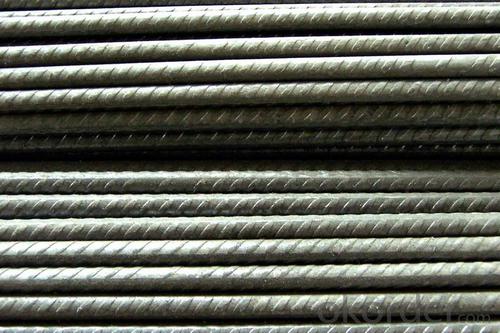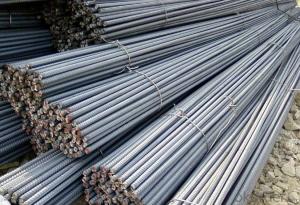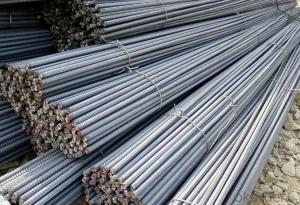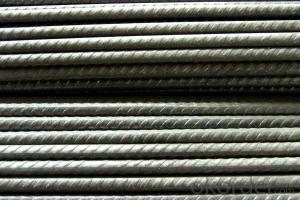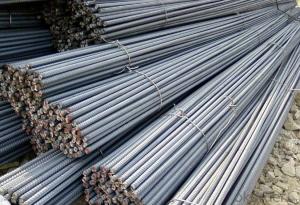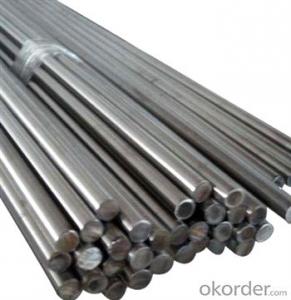Deformed Bar High Quality Hot Rolled 6MM-50MM
- Loading Port:
- Tianjin
- Payment Terms:
- TT or LC
- Min Order Qty:
- 25 m.t.
- Supply Capability:
- 10000 m.t./month
OKorder Service Pledge
OKorder Financial Service
You Might Also Like
Product Description:
OKorder is offering high quality Hot Rolled Steel I-Beams at great prices with worldwide shipping. Our supplier is a world-class manufacturer of steel, with our products utilized the world over. OKorder annually supplies products to European, North American and Asian markets. We provide quotations within 24 hours of receiving an inquiry and guarantee competitive prices.
Product Applications:
Deformed bar is widely used in buildings, bridges, roads and other engineering construction. Big to highways, railways, bridges, culverts, tunnels, public facilities such as flood control, dam, small to housing construction, beam, column, wall and the foundation of the plate, deformed bar is an integral structure material. With the development of world economy and the vigorous development of infrastructure construction, real estate, the demand for deformed bar will be larger and larger
Product Advantages:
OKorder's Steel I-Beams are durable, strong, and resist corrosion, exact size, regular package, chemical and mechanical properties are stable.
Main Product Features:
· Premium quality
· Prompt delivery & seaworthy packing (30 days after receiving deposit)
· Corrosion resistance
· Can be recycled and reused
· Mill test certification
· Professional Service
· Competitive pricing
Product Specifications:
Manufacture: Hot rolled
Grade: BS4449
Certificates: ISO, SGS, BV, CIQ
Diameter: 6mm,8mm,10mm,12mm,14mm,16mm,18mm,20mm,
22mm,25mm,28mm,32mm,36mm,40mm,50mm
Length: 6M, 9M,12M or as required
Packaging: Export packing, nude packing, bundled
Chemical Composition: (Please kindly find our chemistry of our material based on HRB500 as below for your information)
Grade | Technical data of the original chemical composition (%) | ||||||
C | Mn | Si | S | P | V | ||
HRB400 | ≤0.25 | ≤1.60 | ≤0.80 | ≤0.045 | ≤0.045 | 0.04-0.12 | |
Physical capability | |||||||
Yield Strength (N/cm²) | Tensile Strength (N/cm²) | Elongation (%) | |||||
≥400 | ≥570 | ≥14 | |||||
Theoretical weight and section area of each diameter as below for your information:
Diameter(mm) | Section area (mm²) | Mass(kg/m) | Weight of 12m bar(kg) |
6 | 28.27 | 0.222 | 2.664 |
8 | 50.27 | 0.395 | 4.74 |
10 | 78.54 | 0.617 | 7.404 |
12 | 113.1 | 0.888 | 10.656 |
14 | 153.9 | 1.21 | 14.52 |
16 | 201.1 | 1.58 | 18.96 |
18 | 254.5 | 2.00 | 24 |
20 | 314.2 | 2.47 | 29.64 |
22 | 380.1 | 2.98 | 35.76 |
25 | 490.9 | 3.85 | 46.2 |
28 | 615.8 | 4.83 | 57.96 |
32 | 804.2 | 6.31 | 75.72 |
36 | 1018 | 7.99 | 98.88 |
40 | 1257 | 9.87 | 118.44 |
50 | 1964 | 15.42 | 185.04 |
FAQ:
Q1: How do we guarantee the quality of our products?
A1: We have established an advanced quality management system which conducts strict quality tests at every step, from raw materials to the final product. At the same time, we provide extensive follow-up service assurances as required.
Q2: How soon can we receive the product after purchase?
A2: Within three days of placing an order, we will begin production. The specific shipping date is dependent upon international and government factors, but is typically 7 to 10 workdays.
Q3: What makes stainless steel stainless?
A3: Stainless steel must contain at least 10.5 % chromium. It is this element that reacts with the oxygen in the air to form a complex chrome-oxide surface layer that is invisible but strong enough to prevent further oxygen from "staining" (rusting) the surface. Higher levels of chromium and the addition of other alloying elements such as nickel and molybdenum enhance this surface layer and improve the corrosion resistance of the stainless material.
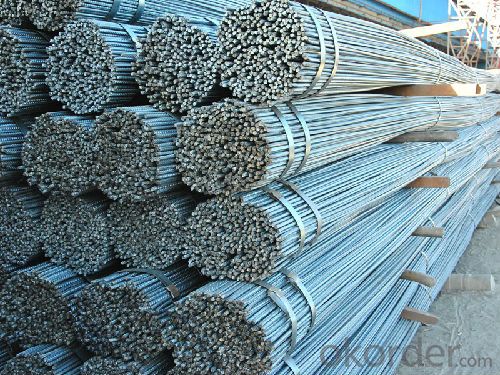
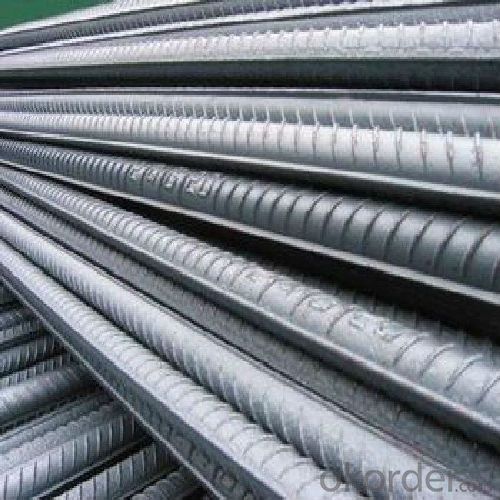
- Q: What is the elongation of steel rebars?
- The elongation of steel rebars refers to the amount of deformation or stretching the rebars can undergo before they reach their breaking point.
- Q: How do steel rebars affect the overall seismic performance of buildings?
- Steel rebars play a crucial role in enhancing the overall seismic performance of buildings. These reinforced bars, when properly integrated into the structural system, provide significant strength and ductility to the building, allowing it to withstand seismic forces more effectively. One of the key benefits of steel rebars is their ability to increase the tensile strength of concrete structures. Concrete is strong in compression but weak in tension. By placing steel rebars within the concrete, the tensile strength is greatly improved, preventing the concrete from cracking or failing under the stress of seismic forces. In the event of an earthquake, steel rebars help distribute the seismic forces throughout the structure, minimizing localized damage and ensuring a more uniform response. The rebars act as a network of interconnected elements, transferring the energy created by the earthquake to the surrounding areas, thereby reducing the vulnerability to localized failures. Moreover, steel rebars enhance the ductility of the building, which is the ability to deform without losing structural integrity. During an earthquake, buildings experience significant lateral forces, and the ductility provided by the rebars allows the structure to absorb and dissipate these forces through controlled deformation. This prevents sudden and catastrophic failure, giving occupants more time to evacuate safely. Additionally, steel rebars can be strategically placed in critical areas of the building, such as at beam-column connections, where the highest stresses occur during an earthquake. By reinforcing these vulnerable points, the rebars ensure that the building maintains its structural integrity and remains resistant to collapse. In summary, steel rebars significantly improve the overall seismic performance of buildings by increasing tensile strength, distributing seismic forces, enhancing ductility, and reinforcing critical areas. Their integration into the structural system helps mitigate the potential for damage and ensures the safety of occupants during seismic events.
- Q: What are the common applications of steel rebars?
- Steel rebars are commonly used in the construction industry for reinforcing concrete structures such as buildings, bridges, highways, and dams. They provide strength, durability, and stability to the concrete, enhancing its load-bearing capacity and resistance to tension and bending forces.
- Q: How are steel rebars affected by long-term exposure to water?
- Steel rebars are susceptible to corrosion when exposed to water for a prolonged period. The presence of moisture and oxygen initiates an electrochemical reaction, causing the steel to rust and gradually weaken over time. This can compromise the structural integrity of the rebars and the surrounding concrete, leading to potential structural failure if not addressed.
- Q: What is the role of steel rebars in minimizing the risk of structural collapse?
- Steel rebars play a critical role in minimizing the risk of structural collapse in buildings and other construction projects. These reinforcing bars, commonly known as rebars, are made from steel and are used to reinforce concrete structures. They provide additional strength and durability to the concrete, making it more resistant to various forces and reducing the likelihood of collapse. One of the primary causes of structural failure is the inability of a building or structure to withstand the forces it experiences. These forces can include the weight of the structure itself, as well as external forces such as wind, earthquakes, and even human activities. Without proper reinforcement, concrete alone may not be able to bear these forces, leading to structural collapse. Steel rebars are strategically placed within the concrete to enhance its tensile strength. While concrete is very strong in compression, it is relatively weak in tension. By adding steel rebars, the concrete becomes much more resistant to tension and can better resist bending and cracking. This reinforcement allows the structure to distribute loads more evenly and prevents localized failures. Furthermore, steel rebars also help to control and limit the propagation of cracks within the concrete. In the event of a crack formation, the rebars act as a barrier and hold the concrete together, preventing further cracking and potential collapse. This is especially important in areas prone to seismic activities, as the rebars can help dissipate and absorb the energy generated by an earthquake. In addition to their structural role, steel rebars also contribute to the longevity and durability of the concrete structure. By reinforcing the concrete, rebars help to prevent corrosion and degradation caused by environmental factors such as moisture and chemicals. This ensures that the structure remains intact and stable over a longer period of time, reducing the risk of collapse due to deterioration. In summary, the role of steel rebars in minimizing the risk of structural collapse is crucial. They provide additional strength and durability to the concrete, enhancing its ability to withstand various forces and preventing failure. By reinforcing the concrete, rebars distribute loads, control crack propagation, and contribute to the longevity of the structure, ultimately ensuring the safety and stability of buildings and other construction projects.
- Q: How are steel rebars stored and transported?
- Steel rebars are typically stored and transported in bundles or coils. They are commonly stored in open yards or warehouses, with proper stacking and support to prevent damage or deformation. During transportation, rebars are loaded onto trucks or flatbed trailers, secured with straps or chains to ensure stability, and transported to construction sites or steel fabrication facilities.
- Q: What are the different types of steel rebars used in foundation construction?
- Foundation construction commonly utilizes various types of steel rebars. These include: 1. Mild Steel Rebars, also known as black bars, are the most frequently employed in foundation construction. They possess a low carbon content and are easy to handle. Mild steel rebars offer satisfactory tensile strength and are cost-effective. 2. High Yield Strength Rebars possess a higher carbon content and undergo heat treatment to enhance their strength. They are commonly applied in areas requiring additional strength, such as high-rise buildings or seismic zones. High yield strength rebars exhibit superior resistance against tensile and compressive forces. 3. Epoxy-Coated Rebars are coated with epoxy resin to safeguard them against corrosion. They are often utilized in areas where the foundation is exposed to moisture or chemicals, such as marine or industrial environments. The epoxy coating acts as a barrier, preventing water and other corrosive substances from reaching the steel and causing rust. 4. Galvanized Rebars are coated with a layer of zinc to shield them from corrosion. The zinc coating provides excellent resistance against moisture and chemicals, making galvanized rebars suitable for use in high humidity areas or in concrete containing chloride ions. They are frequently employed in coastal regions or structures like bridges and parking garages. 5. Stainless Steel Rebars possess high corrosion resistance and are implemented in environments where other types of rebars may fail due to corrosion. They are commonly utilized in structures exposed to aggressive environments, such as chemical plants or wastewater treatment facilities. Stainless steel rebars are also employed in regions with a high risk of corrosion, such as coastal or humid areas. In conclusion, the selection of steel rebars for foundation construction depends on factors such as project requirements, environmental conditions, and the desired level of corrosion resistance. It is crucial to choose the appropriate type of rebar to ensure the durability and strength of the foundation.
- Q: Can steel rebars be used in structures with limited accessibility?
- Indeed, structures with limited accessibility can utilize steel rebars. These rebars are frequently employed in reinforced concrete structures for their ability to enhance strength and durability. They possess versatility, enabling effortless transportation and installation, even in regions with restricted access. Under such circumstances, steel rebars can be conveniently cut, bent, and assembled on-site to precisely accommodate the structure's specific requirements. Furthermore, steel rebars can be prefabricated off-site and subsequently transported to the construction site, facilitating simpler handling and installation in areas with restricted entry. Consequently, steel rebars emerge as a fitting choice for structures located in remote areas or regions with limited available space.
- Q: Can steel rebars be used in the construction of museums and art galleries?
- Yes, steel rebars can be used in the construction of museums and art galleries. Steel rebars provide structural reinforcement and can help ensure the stability and longevity of the building. They are commonly used in the construction industry to reinforce concrete and enhance the overall strength of structures.
- Q: How do steel rebars affect the overall stability of a structure?
- Steel rebars, or reinforcing bars, play a crucial role in enhancing the overall stability of a structure. They are primarily used to reinforce concrete structures and increase their strength and durability. The inclusion of steel rebars significantly improves the structural integrity of a building or any other construction. One of the key ways steel rebars affect the overall stability of a structure is by strengthening the concrete against tensile forces. While concrete is excellent at withstanding compressive forces, it is relatively weak in resisting tension. Steel rebars, with their high tensile strength, help counteract this weakness by absorbing and distributing tensile forces throughout the structure. This prevents the concrete from cracking or collapsing under excessive tensile loads, thereby enhancing the stability. Moreover, steel rebars also improve the structural stability by enhancing the flexural strength of a structure. Flexural strength refers to a structure's ability to withstand bending or flexing without deforming or failing. By adding steel rebars to reinforced concrete beams, columns, or slabs, the overall flexural strength of the structure increases significantly. This helps prevent excessive deflection and ensures the structure can bear the loads it is subjected to, such as the weight of the building, live loads, or external forces. Additionally, steel rebars contribute to the stability of a structure by resisting shear forces. Shear forces occur when two parts of a structure slide or move in opposite directions. These forces can cause structural failure if not adequately addressed. Steel rebars, when properly placed and anchored, restrain the concrete from shearing, thus preventing potential collapse or instability. Furthermore, steel rebars also improve the stability of a structure by enhancing resistance to seismic forces. In earthquake-prone areas, the inclusion of steel rebars provides the necessary ductility and energy dissipation capacity to withstand seismic activity. The rebars act as a network of interconnected elements, distributing the seismic forces and ensuring the structure remains stable during an earthquake. In conclusion, steel rebars greatly influence the overall stability of a structure by reinforcing concrete against tensile forces, enhancing flexural strength, resisting shear forces, and improving resistance to seismic activity. Their inclusion significantly increases the strength, durability, and integrity of a construction, ensuring it can withstand various loads, forces, and potential hazards, thereby enhancing the overall stability of the structure.
Send your message to us
Deformed Bar High Quality Hot Rolled 6MM-50MM
- Loading Port:
- Tianjin
- Payment Terms:
- TT or LC
- Min Order Qty:
- 25 m.t.
- Supply Capability:
- 10000 m.t./month
OKorder Service Pledge
OKorder Financial Service
Similar products
Hot products
Hot Searches
Related keywords



